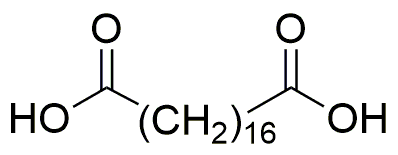Octadecanedioic acid is widely utilized in research focused on:
- Polymer Production: This compound serves as a key ingredient in the synthesis of polyamides and polyesters, which are essential in manufacturing durable plastics and fibers used in textiles and automotive parts.
- Cosmetic Formulations: Its emollient properties make it a valuable addition to skin care products, providing moisture and improving texture, thus enhancing the overall feel of creams and lotions.
- Food Industry: Used as a food additive, it acts as a stabilizer and emulsifier, improving the consistency and shelf-life of various food products.
- Biodegradable Materials: Researchers are exploring its potential in creating eco-friendly materials, contributing to sustainability efforts in packaging and product design.
- Pharmaceutical Applications: It is being investigated for its role in drug delivery systems, where its properties can help in the controlled release of medications, improving therapeutic efficacy.
Información general
Propiedades
Seguridad y normativas
Aplicaciones
Octadecanedioic acid is widely utilized in research focused on:
- Polymer Production: This compound serves as a key ingredient in the synthesis of polyamides and polyesters, which are essential in manufacturing durable plastics and fibers used in textiles and automotive parts.
- Cosmetic Formulations: Its emollient properties make it a valuable addition to skin care products, providing moisture and improving texture, thus enhancing the overall feel of creams and lotions.
- Food Industry: Used as a food additive, it acts as a stabilizer and emulsifier, improving the consistency and shelf-life of various food products.
- Biodegradable Materials: Researchers are exploring its potential in creating eco-friendly materials, contributing to sustainability efforts in packaging and product design.
- Pharmaceutical Applications: It is being investigated for its role in drug delivery systems, where its properties can help in the controlled release of medications, improving therapeutic efficacy.
Documentos
Hojas de datos de seguridad (HDS)
La SDS proporciona información de seguridad completa sobre la manipulación, el almacenamiento y la eliminación del producto.
Especificación del producto (PS)
La PS proporciona un desglose completo de las propiedades del producto, incluida la composición química, el estado físico, la pureza y los requisitos de almacenamiento. También detalla los rangos de calidad aceptables y las aplicaciones previstas del producto.
Certificados de análisis (COA)
Busque certificados de análisis (COA) ingresando el número de lote del producto. Los números de lote y de partida se pueden encontrar en la etiqueta de un producto después de las palabras "Lote" o "Lote".
Número de catálogo
Número de lote/lote
Certificados de origen (COO)
Este certificado de origen confirma el país en el que se fabricó el producto y también detalla los materiales y componentes utilizados en él y si se deriva de fuentes naturales, sintéticas u otras fuentes específicas. Este certificado puede ser necesario para cumplir con las normativas aduaneras, comerciales y regulatorias.
Número de catálogo
Número de lote/lote
Hojas de datos de seguridad (HDS)
La SDS proporciona información de seguridad completa sobre la manipulación, el almacenamiento y la eliminación del producto.
DownloadEspecificación del producto (PS)
La PS proporciona un desglose completo de las propiedades del producto, incluida la composición química, el estado físico, la pureza y los requisitos de almacenamiento. También detalla los rangos de calidad aceptables y las aplicaciones previstas del producto.
DownloadCertificados de análisis (COA)
Busque certificados de análisis (COA) ingresando el número de lote del producto. Los números de lote y de partida se pueden encontrar en la etiqueta de un producto después de las palabras "Lote" o "Lote".
Número de catálogo
Número de lote/lote
Certificados de origen (COO)
Este certificado de origen confirma el país en el que se fabricó el producto y también detalla los materiales y componentes utilizados en él y si se deriva de fuentes naturales, sintéticas u otras fuentes específicas. Este certificado puede ser necesario para cumplir con las normativas aduaneras, comerciales y regulatorias.

